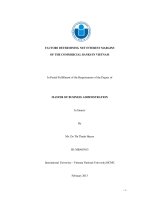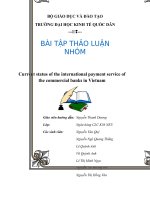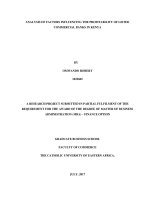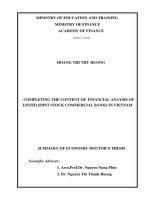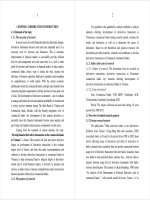Tiểu luận current status of the international payment service of the commercial banks in vietnam
Bạn đang xem bản rút gọn của tài liệu. Xem và tải ngay bản đầy đủ của tài liệu tại đây (265.5 KB, 14 trang )
BỘ GIÁO DỤC VÀ ĐÀO TẠO
TRƯỜNG ĐẠI HỌC KINH TẾ QUỐC DÂN
------
BÀI TẬP THẢO LUẬN
NHÓM
Current status of the international payment service of
the commercial banks in Vietnam
Giáo viên hướng dẫn: Nguyễn Thanh Dương
Lớp:
Ngân hàng CLC K56 NEU
Các sinh viên:
Nguyễn Văn Quý
Nguyễn Ngô Quang Thắng
Lê Quỳnh Anh
Vũ Quỳnh Anh
Lê Thị Minh Ngọc
Nguyễn Thị Hoàng Hà
Nguyễn Thị Hồng Vân
- Hà Nội, 2017 -
Current status of the international payment
service of the commercial banks in Vietnam
I. Definition
1. Definition:
- International payment is the process of making international currency
revenues and expenditures through the banking system around the world in order
to serve the international exchange relations arising among countries.
- International payment is one of the bank's operations in paying the value of
shipments between buyers and sellers in the field of foreign trade.
2. Characters:
2.1 Payment relating to currency, place, means, modes and time of
payment
a. Currency: All parties in the international payment must agree on a currency
to secure the value of international transactions.
- In general , there are two types of currency used in international payment: the
currency of payment and the currency of caculation.
+ Money for calculations: usually stable currency or strong currency (eg USD,
EURO, ...)
+ Money for payment: the money that the two parties used to pay for each
other. The payment currency must be a freely convertible currency and then
disseminated to the international payment practice.
+ Payment currency and computed currency can be the same currency or 2
different currencies.
b. Means: The most means frequently used are drafts, bill of exchange, cash,
but the most common is BE.
c. Method: There are many methods of payment such as money transfer
method, method of recording books, method of collection, mode of credit
voucher ... each mode has different advantages and disadvantages. The conflicts of
benefit between the exporter and the importer. The choice of payment method is
specified in the foreign trade contract.
d. Place of payment: The parties can choose a place as payment facility, which
depends on the requirements of the business and the relationship between the
parties.
e. Payment terms: can be prepaid, postpaid, or mixed. Time limits are usually
the date of the draft, the date of acceptance of the draft, or any time frame agreed
upon by the parties.
2.2. International payment for external economic activities, non-trade,
investment, finance
- Payment is an important step in the process of production and circulation of
goods, especially for export and import activities.
- Well-organized international payment => the value of goods exchanged and
services performed between entities in different countries will be implemented,
contributing to the development of foreign trade.
- International settlement became an important factor in evaluating a nation's
economic efficiency.
- International payments also serve non-commercial non-commercial activities
such as payment of expenses by diplomatic missions, etc.
2.3. International payments are more risky than domestic payments
- Unlike domestic payments, international payments are more vulnerable to
currency fluctuations, political instability, legal differences, and policy
mechanisms across countries, due to Geographic distance between countries
involved in international payment operations.
As a result, exporters, importers and banks are passive in the fulfillment of
their committed obligations, causing damage to the parties involved.
II. Methods of international payment
1 Bank transfer
b Definition : is a method of transferring money by instructing a bank to
directly transfer funds from one bank account to another without the use of check
c Parties :
∗ Remitter
∗
∗
∗
d
Remitting bank
Paying bank
Beneficiary
Types of bank transfer
Mail transfer
Requirements of payment
implemented through a letter
Low expense
Low time
e Procedure of bank remittance
Telegraphic transfer
is
Requirements of payment is
implemented through fax, Telex and
using SWIFT system
High expense
Fast time
f Advantages and disadvantages
Advantages
Fast transaction, few documents
Disadvantages
Exporter and importer trust each
other
Have enough foreign currency to
Exporter and importer trust partner
pay
Pay at any branch of the bank
g Apply case in commercial activities
∗ Importer pay for the transaction when goods were loaded on board
∗ Exporter finish to delivery the goods
∗ Importer receive goods
∗ Importer pay partially of the international sale contract
2. Open account
a Definition: it means that the seller delivers goods or services to the buyer
without receiving cash, a bill of exchange or any other legally binding and
enforceable undertaking at the time of delivery, and the buyer is expected to pay
according to the terms of the sales contract and the seller’s latter invoice.
b Features
∗ It is the most advanteageous option to the importer in cash flow and cost
terms
∗ It is the highest risk option for an exporter because his goods along with all
the necessary documents are shipped directly to the importer agreeing to pay the
exporter’s invoice at a future date
∗ Exporter should be absolutely confident that the importer will accept
shipment and pay at agreed time and that the importing country is commercially
and polically secure.
∗ The exporter and importer trust another implicitly and they have traded
together for a number of years
c Procedure of open account payment
d Advantages
Exporter
Importer
Both parties
Easiest payment method, low
expense, friendly payment method
Reduce document expense
Reduce goods prices
Increase exporter’s completion
in international market
Pay the goods after receiving all
of the cargo
To be credited by the exporter
in specific duaration time
Reduce bank expense: Bnk does
not participate in open account
method
There are only 2 parties to be
exporter and importer
e Risks in method of open account payment
Exporter
Importer
The exporter has not control
over the goods
The exporter cannot be
guaranted payment
The open account is perhaps
the riskest method of trade
available
The seller annot deliver goods
on category, time, quantity and
quality
f Apply cases
∗ Exporter and importer trust each other
∗ Use in regular transactions : from 6 months to 1 year
∗ Use in pay transport expense, commission expense, guarantee expense,
interest rate expense
3. Collection of payment
a Definition: it is process, in which after deliver the goods. The seller instructs
his bank to forward documents related to the export of goods to the buyer’s bank
with a request to present these documents to the buyer for payment, indicating
when and on what conditions these documents can be released to the buyer.
b Features
∗ Collection order between exporter snd exporting bsnk is not a contract
∗ Banks are only intermediary in payment method
∗ It is only implemented after the seller delivers goods basing on issuing
documents
c Documents in collection of payment
- Financial documents:
∗ banker’s bill of exchange, draft
∗ commercial promissory note
∗ Check
- Commercial documents:
∗ Transport documents: seaway bill, airway bill, post receipt
∗
∗
d
e
Owning documents: trust documents, packing list, commercial invoice, CO
Other cargo documents
Parties
Principal
Remitting bank
Collecting bank and presenting bank
Drawee
Types of collection of payment
collection of payment
clean collection: is collection of financial
documents without attached commercial
documentary collection: is collection of financial documents, which may
documents
have attached commercial documents or collection of commercial
documents without financial documents
D/P( dilivery documents aganist payment): the
D/A( delivery documents against acceptance) : the
collecting bank releases the documents to the buyer
collecting bank is permitted to release the
only upon full and immediate cash payment. D/P
documents to the buyer against
terms most closely resemble a traditional cash on
acceptance( signing) of a bill of exchange or signing
delivery transaction
of a time draft at the bank promising to pay at a
later date
4. Documentary credit
a Definition : it is the written promise of a bank undertake on behalf of
a buyer, to pay a seller the amount specified in the credit provided the
seller complies with the terms and conditions set forth in the credit.
The terms and conditions of a documentary credit revolve ảound 2
D/OT or D/
against other
feature
issues: (1) the presentation of documents that evidence title to goods
shipped by the seller, (2) payment.
b Features of LC
- LC is different from international sale contract and it separates with sale
contract
- LC is considered to be an economic contract between importing bank and
importer
- Documents play a very important role in payment activities
- The documentary credit method is the safest payment method among parties
in international payment
c Parties
- Applicant
- Opening bank
- Beneficiary
- Advising bank
- Negotiable bank
- Confirming bank
- Norminated bank
- Paying bank
- Accepting bank
- Bank by deferred payment
d Standard types of LC
- Revocable LC: LC that may be amended or canceled any time by the buyer
without the approval of the seller
- Irrevocable LC: this LC cannot be canceled ( or its term amended) without
the seller’s prior written approval, and comes usually as a confirmed irrevocable
letter of credit
- Confirmed Irrevocable LC: LC that adds the endorsement of a seller’s bank
to that of the buyer’s bank. It provides the highest level of protection to the seller
because not only the LC cannot be canceled unilaterally by the buyer, but also both
banks involves in the transaction guaranty its payment on its due date.
- Irrevocable without Recourse LC
e Procedure:
III. Role of bank
The importance of the role played by banks in trade finance. Commercial
banks play an important role in international trade. Commercial banks act as
intermediaries between importers and exporters. They have insight and wide
practical experience in foreign trade coupled with legal knowledge of provision in
different countries. Banks have correspondents in most countries, through whom
they deal woth the counter parties. Some banks may have their own branches in
other countries.
Banks provide a multitude of services to every operator in the trade
chain and for every stage of any transaction. The most complex deals can require
pre-shipment and post-shipment finance, advances against goods in transit, in
warehouse, in customs or even in the consignee’s possession. Apart from granting
pure trade-related credit, banks protect their customers, whether exporters or
importers, against every type of risk they are likely to encounter by employing a
range of guarantees, standby credits and indemnities. Particular mention must be
made of the importance of documentary credits and the skill that bank operators
display when issuing and confirming credits, paying and negotiating documents.
Exporters are able to enjoy the guarantee of payment which banks provide and
importers can be confident that the documentation they have demanded has been
carefully scrutinized
In addition to finance, banks provide a number of support services
essential to exporters and importers wishing to enter new markets. Credit and
status reports on foreign operators, advance details of overseas contracts and
government tenders are regularly supplied to customers seeking trading
opportunities.
IV. Services offered by commercial banks:
The finance of international trade forms an important part of any major
bank’s service package. Many have specialised departments to handle the various
aspects involved, comprising experienced staff able to cope up with the demands
of customers with overseas business to transact. Commercial banks offer various
types of services to local and international business communities. These services
include financial facilities to exporters and importers by way of loán and
overdrafts, discounting and purchasing of bill of exchange.
- Trade Enquiries: Banks with overseas branch networks or correspondent
banking relationships are able to identify potential markets for their exporting
customers, and assist to an extent with the introduction to their importing customer
overseas.
- Credit information: by using the standard form of bank-to-bank status
enquiry, it is posssible for banks based in the UK to obtain information on
importers, for instance, in respect of their creditwwothiness, from banks overseas.
- Economic and political reports: many large international banks employ
economists who provide reports on a number of countries, which are useful to
exporters, particularly if the country concerned is politically unstable or its
economy is weak.
- Travel services: in addition to the usual services avaiable to the travelling
business executive, such as travellers’ cheques and foreign currency, the banks may
also be able to provide a letter of introduction addressed to their overseas branch or
correspondent. This letter introduces the customer and requests that all possible
assistance is given so that local trading terms and conditions may be fully
understood.
- Exchange control regulations: many countries have restrictions on the
amount of local and(or) foreign currency that can be taken into and out of the
country at any one of time. Consequently, an exporter who is unaware of the
current situation may export goods to a country and then find that the importer is
unable to transfer the funds due in settlement without the sanction of the Central
bank. Banks are able to provide their customers with advice to advoid such
problems.
- Sale and Purchase of foreign currencies/exchange contracts: banks sell
and purchase foreign currencies to and from their customers/non-customers and
travellers. An exporter may find that before payment in forein currency is received
the exchange rate has reduced thus reducing profit on the transaction. It’s possible
for an exporter to enter into a forward exchange contract with a bank, which
enables the bank to fix the exchange rate at which the currency will be converted
on a specified date in the future. Then, the exporter can price goods safe in the
knowledge that the rrate will not change whatever happens in the foreign exchange
markets. The bank covers its own commitment by matching deals in the market.
- Collection of bills: a exporter who has drawn a bill of exchange on an
overseas buyer í able to obtain reimbursement by asking their bank to send the bill
to the importer’s bank i.e an exporter’s bank will collect the proceeds. When a
bank is asked to collect a bill of exchange, it acts as agent to the exporter.
V. Current status of international payment in Petrolimex
Group Commercial Joint stock bank (PG Bank).
I. Transfer money methods
At PG Bank, the main means used in the money transfer is Telegraphic
Transfer, money transfer by mail is almost no longer used.
The method of transfer money extremely quick and simple, the Vietnam
export and import enterprises to choose to use for many years when working
with foreign partners, on the basis of mutual trust. And now this method is also
applied quite popular, suitable for transactions with small and medium pay
In 2009 and 2010, remittance turnover accounted for a significant
proportion of total international payment at PG Bank
Quarte
r
I/2009
II/2009
III/2009
IV/200
I/2010
9
Sales
5,024.5
7,723.5
12,028
13,020
13,279
transfer
money
away
Sakes
12,509.
12,948
15,987.
17,340
17,513.
transfer
75
75
5
money to
.Money transfer activities at PG Bank are always highly reputable, with
automatic and highly accurate transactions. The transactions at PG Bank rarely
cause errors in the operation, only sometimes when order money transfer is not
made immediately due to slow internet connection.
II.Collection method with documents
This method of collection has quick procedures, service charges are not
high so also many customers choose. However, the amount of payment by
collection is not much and mainly done in the form of collection of documents,
because it has many risks as well as not guarantee the rights of the parties .
Quarte
I/2009
II/2009
III/2009
r
IV/200
I/2010
9
Export
200
775
1,243
1,439
7,587
collection
Import
850
1,180
2,111
3,844
4,123
collection
Payment collection at PG Bank actually generated some risks associated
with both buyers and sellers. There is a case where the buyer has accepted the
payment but the maturity date is not fulfilled. And the staff of the payment
office of PG Bank must contact and urge buyers to fulfill their obligations.
When acting as collecting bank, PG Bank also incurred some risks due to the
seller's breach of contract. It is the buyer who wants to have the receipt of the
goods sent a commitment to accept payment to PG Bank but after receiving the
goods again delay payment due to the reason of incorrect delivery. And PG
Bank had to lend money to the borrower to pay to the foreign bank upon
maturity
III. Payment methods-Documentary Credit or Letter of Credit. (L/C)
L/C is usually the best choice of enterpreneurs. In the operation of international
payment at PG Bank, payment values using L/C is the highest.
Figure 1: The situation of payment by L/C in 2009
Value ( thousand USD)
Open L/C
71,025.45
For import
49,791.97
For export
86,508.81
Figure 2: The situation of payment by L/C in 2010
L/C import
Number of
Value
Number of items
275
328
160
L/C export
Number of
Value
items
January/2010 65
Feb/2010
45
Mar/2010
49
(thousand
USD)
38,534.27
29,808.99
37,022.93
items
44
24
25
(thouand
USD)
18,708.11
28,491.23
19,494.19
- The operations using L/C at PG Bank also have risks. Many cases incurred
due to an error of the Bank, for example when Documentary Credit sent
from foreign banks, Receptionist staff received the documents but forgot to
transfer to the International Payment room . And the document stays in the
employee's cabin for more than 5 business days until the foreign bank
requests payment. PG Bank got a mistake about it and paid it to the foreign
bank, though we did not scrutinize the documents.
- Another risk arises when the customer becomes insolvent. It happened when
PG Bank issued to Shanghai Vietnam a Deferred L / C with the total amount
of USD 5.7 million. In the course of business, the company suffered a loss,
went to bankrupt, unable to repay the bank, and eventually made up to 50%
of the amount of debt.

